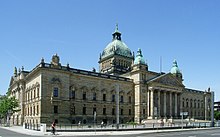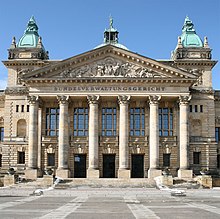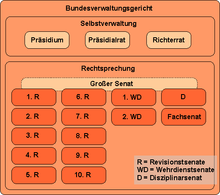Federal Administrative Court (Germany)
|
|||
|---|---|---|---|
| State level | Federation | ||
| position | Federal Supreme Court | ||
| Supervisory body (s) | Federal Ministry of Justice and Consumer Protection | ||
| Consist | since 1952 ( BGBl. I p. 625, 635 ) | ||
| Headquarters |
Leipzig , Saxony |
||
| management | Klaus Rennert , President of the Federal Administrative Court | ||
| Website | www.bverwg.de | ||
The Federal Administrative Court ( BVerwG ) is the highest court in the Federal Republic of Germany in public law disputes of a non-constitutional nature and, alongside the Federal Labor Court , the Federal Court of Justice , the Federal Fiscal Court and the Federal Social Court, one of the five highest federal courts . It has its seat in the building of the former Imperial Court in Leipzig .
As an authority , the Federal Administrative Court, like the Federal Fiscal Court and the Federal Court of Justice, is subordinate to the portfolio of the Federal Ministry of Justice and Consumer Protection (BMJV) and is subject to its general supervision . However , it is independent in its work as a court .
history
The Federal Administrative Court was established on the basis of Article 95, Paragraph 1 of the Basic Law by law of 23 September 1952 ( Federal Law Gazette I p. 625 ). The seat of the Federal Administrative Court was initially Berlin . Since June 8, 1953, the Federal Administrative Court was housed in the former rooms of the Prussian Higher Administrative Court . The decision in favor of Berlin as the official seat was controversial among the occupying powers ; the Soviet Union in particular was hostile to this. As a result, with the rearmament of the Federal Republic, the military service senate of the Federal Administrative Court had to move to Munich . Since the Federal Administrative Court moved from Berlin to Leipzig into the Imperial Court building , they too have resided in Leipzig.
Leipzig was determined by the law of November 21, 1997 as the new seat of the Federal Administrative Court. Section 2 of the Administrative Court Regulations was changed accordingly. The official day of the change of seat was set on August 26, 2002 by the Federal Minister of Justice by ordinance of June 24, 2002. The latest chapter in the history of the Federal Administrative Court is thus linked to the use of the former Reich Court building in Leipzig - it officially began with the inauguration of the building as a Federal Administrative Court on September 12, 2002.
As a result of the COVID-19 pandemic in Germany , the Federal Administrative Court is restricting its activities from March 18 to probably April 19, 2020. Oral negotiations only take place in matters that cannot be postponed, the service building was closed.
Court organization and tribunal
The Federal Administrative Court currently has 13 senates : ten revision senates , two military service senates and one specialist senate (on the latter: Section 189 in conjunction with Section 99 (2) VwGO). There used to be three disciplinary senates, which were dissolved in 1971, 2004 and 2015. Five to seven professional judges are appointed to the revision panels; Decisions are made with five judges, and with decisions outside the oral hearing with three judges ( Section 10 (3) VwGO). Three professional judges are appointed to the military service senates; In the case of an oral hearing, they decide with the help of two honorary judges from the Bundeswehr. Four professional judges are appointed to the specialist senate, parallel to their membership in one of the other senates; it decides with three judges. A total of 56 professional judges work as planned at the Federal Administrative Court. The proportion of women is currently (2017) with 14 out of 56 people 25%.
The division of responsibilities and the composition of the 13 senates is determined by the current division of responsibilities. Currently (as of 2019), the following roughly responsible responsibilities exist:
I. Revision Senate
- 1. Revision Senate : Law on foreigners and asylum , law of expellees , law of citizenship
- 2. Revision Senate : Law of the public service , including procedures according to the Federal Disciplinary Act
- 3. Revision Senate : General Law on Consequences of War , Home Law , compensation and compensation claims from various laws, agricultural , hunting , animal and food law , foreign trade law, traffic law
- 4. Revision Senate : Building , Land and Regional Planning Law, Nature Conservation Law , Monument Protection Law
- 5. Revision Senate : Law of public welfare, training law, youth protection law, severely handicapped rights including the compensation claims according to the General Equal Treatment Act and the Soldiers Equal Treatment Act in the event of discrimination because of a disability, compensation claims from various laws
- 6. Revision Senate : Compulsory military service and civil service law, school and university law, naming law, media law , police and regulatory law , intelligence law, electoral law, state church law
- 7. Revision Senate : environmental law , in particular chemicals and pollution control law , nuclear law , water and dike law , mining law , Railway Crossing Act
- 8. Revision Senate : Open property questions , settlement of SED injustice , economic administration law , currency law, trust law
- 9. Revision Senate : Road and right of way , development rights, land consolidation and the right of rural property traffic , disputes concerning the Fehmarnbelt crossing between Puttgarden and the German-Danish border
- 10. Revision Senate : Freedom of information law , environmental information law , press, radio, archive and media law information, inspection and information rights
II. Expert panel according to § 189 VwGO : In-camera procedure
III. Military Service Senate
- 1. Military service senate : Procedure according to the military complaints regulations
- 2. Military service senate : Procedure according to the military disciplinary code
IV. Grand Senate ( Section 11 VwGO)
V. Judge within the meaning of § 173 sentence 1 VwGO in connection with § 278 paragraph 5 sentence 1 ZPO
Procedure
The Federal Administrative Court acts mainly as a review body in administrative matters against decisions of the Higher Administrative Courts (OVG), which in some federal states are called "Administrative Court " ( Section 49 VwGO ). For the requirements - in particular the necessary approval of the revision by the OVG or the BVerwG - see §§ 132 ff. VwGO. In exceptional cases, a leap revision against the judgment of an administrative court directly to the BVerwG is permitted ( Section 134 VwGO). The successful revision presupposes the assertion and existence of one (or more) of the reasons for the revision mentioned in § 137 and § 138 VwGO.
As an exception, the Federal Administrative Court also acts in the first, but then also in the last instance ( Section 50 VwGO). The Federal Administrative Court is the first instance
- public law disputes of a non-constitutional nature between the federal government and the states, as well as between different states;
- Actions against the Minister of the Interior ( Ministry of the Interior - BMI) over after § 3 Abs 2 # 2.. VereinsG pronounced club prohibitions and to § 8 adopted paragraph 2, p 1 VereinsG orders;.
- Disputes against deportation orders according to § 58a Residence Act and their execution;
- Lawsuits based on processes in the business area of the Federal Intelligence Service (BND);
- Lawsuits against measures and decisions according to Section 44a of the Law on Representatives , according to the rules of conduct for members of the German Bundestag , according to Section 6b BMinG and according to Section 7 ParlStG in conjunction with Section 6b BMinG;
- Disputes relating to planning approval procedures and planning approval procedures for certain important transport infrastructure projects , which are specified in the General Railway Act , the Federal Trunk Road Act , the Federal Waterways Act or the Magnetic Levitation Railway Planning Act (MBPlG);
- Public-law disputes of a non-constitutional nature according to the Financial Market Stabilization Fund Act ( § 16 FMStFG).
Through its military service senate, the Federal Administrative Court also acts as an appeal court against decisions of the troop service courts .
Before the Federal Administrative Court there is compulsory representation ( Section 67 VwGO), usually also referred to as compulsory lawyer for short , which means that the parties involved must be represented by a lawyer or a law teacher at a German university (with a qualification for judicial office).
Presidents and Vice Presidents
| No. | Surname | Beginning of the term of office | Term expires |
|---|---|---|---|
| 1 | Ludwig Frege (1884–1964) | March 28, 1953 | December 31, 1954 |
| 2 | Hans Egidi (1890-1970) | April 29, 1955 | June 30, 1958 |
| 3 | Fritz Werner (1906–1969) | July 18, 1958 | December 26, 1969 |
| 4th | Wolfgang Zeidler (1924–1987) | June 15, 1970 | 7th November 1975 |
| 5 | Walther Fürst (1912-2009) | 19th August 1976 | February 29, 1980 |
| 6th | Horst Sendler (1925-2006) | March 1, 1980 | June 30, 1991 |
| 7th | Everhardt Franßen (* 1937) | July 1, 1991 | September 30, 2002 |
| 8th | Eckart Hien (* 1942) | October 1, 2002 | May 31, 2007 |
| 9 | Marion Eckertz-Höfer (* 1948) | June 1, 2007 | January 31, 2014 |
| 10 | Klaus Rennert (* 1955) | since July 1, 2014 | |
| No. | Surname | Beginning of the term of office | Term expires |
|---|---|---|---|
| 1 | Helmut R. Külz (1903–1985) | December 23, 1970 | July 31, 1971 |
| 2 | Walther Fürst (1912-2009) | November 16, 1971 | 18th August 1976 |
| 3 | Horst Sendler (1925-2006) | 19th August 1976 | February 29, 1980 |
| 4th | Johannes Oppenheimer (1918-2007) | March 1, 1980 | July 31, 1986 |
| 5 | Günter Zehner (1923-2002) | August 1, 1986 | August 31, 1990 |
| 6th | Otto Schlichter (1930-2011) | September 1, 1990 | September 30, 1993 |
| 7th | Ingeborg Franke (* 1935) | October 1, 1993 | May 31, 2000 |
| 8th | Eckart Hien (* 1942) | June 22, 2000 | September 30, 2002 |
| 9 | Marion Eckertz-Höfer (* 1948) | October 1, 2002 | May 31, 2007 |
| 10 | Michael Hund (* 1946) | June 1, 2007 | October 31, 2011 |
| 11 | Klaus Rennert (* 1955) | November 21, 2012 | June 30, 2014 |
| 12 | Josef Christ (* 1956) | July 1, 2014 | November 30, 2017 |
| 13 | Andreas Korbmacher (* 1960) | since May 22, 2019 | |
Official costume
The official costume for the judges, the representatives of the federal interest and the clerks at the Federal Administrative Court was determined with the order of the Federal President about the official costume at the Federal Administrative Court .
The official costume consists of an official robe and a beret . A wide, white neck tie with drooping ends is worn with the crimson robe. The clerks wear a simple white collar. The trimmings on the official robe and beret depend on the function. In the case of the judges, the trimmings are made of velvet, in the case of representatives of the federal interest and the officials who appear for them, the trimmings are made of silk and the notarial staff wear robes with trimmings made of wool. The President of the Federal Administrative Court wears three gold cords on the beret, the presiding judge at the Federal Administrative Court two gold cords and the Federal Administrative Court judge two crimson silk cords. The representative of the federal interest at the Federal Administrative Court wears three gold cords on his beret, the officials appearing for him a crimson silk cord.
See also
- Category: Decision of the Federal Administrative Court (Germany)
- Representative of the federal interest at the Federal Administrative Court
- List of German courts
- List of judges at the German Federal Administrative Court
literature
- Eberhard Schmidt-Aßmann , Dieter Sellner, Günter Hirsch , Gerd-Heinrich Kemper, Hinrich Lehmann-Grube (eds.): Declaration 50 years of the Federal Administrative Court . 2003, ISBN 3-452-24052-5 .
- Federal Ministry for Transport, Building and Housing (Ed.): The Federal Administrative Court in Leipzig. Restoration and reconstruction of the former imperial court building . Leipzig 2002, DNB 965669998 . (Published on the occasion of the inauguration of the building on September 12, 2002.)
- Thomas G. Dorsch: The imperial court building in Leipzig. Demand and reality of a state architecture. Lang, Frankfurt am Main 1999, ISBN 3-631-35060-0 (also: Marburg, Univ., Diss., 1998).
Web links
- Official website of the Federal Administrative Court
- BVerfGE 8, 174 - Competence of the BVerwG
- The German Federal Administrative Court as a 3D model in SketchUp's 3D warehouse
- The Federal Administrative Court as a linear panorama; panoramastreetline.de
- Panoramic night shot of the Federal Administrative Court. gigapan.com
Individual evidence
- ↑ Note in the imprint in: Federal Ministry of Transport, Building and Housing (Ed.): The Federal Administrative Court in Leipzig. Restoration and reconstruction of the former imperial court building . Leipzig 2002, DNB 965669998 .
- ↑ Limited activities of the Federal Administrative Court from March 18, 2020. Federal Administrative Court, March 17, 2020, accessed on March 22, 2020 .
- ↑ Federal Administrative Court - division of responsibilities as of May 2017 (accessed on December 11, 2017; PDF).
- ↑ Business allocation plan of the Federal Administrative Court for the 2019 financial year as of September 2, 2019 (PDF, 167 kB; accessed on October 24, 2019).
- ↑ Press release May 22, 2019. In: bverwg.de. Federal Administrative Court, accessed on May 22, 2019 .
- ^ Text of the order on the official costume at the Federal Administrative Court (PDF; 21 kB).
Coordinates: 51 ° 19 ′ 59 ″ N , 12 ° 22 ′ 11 ″ E









